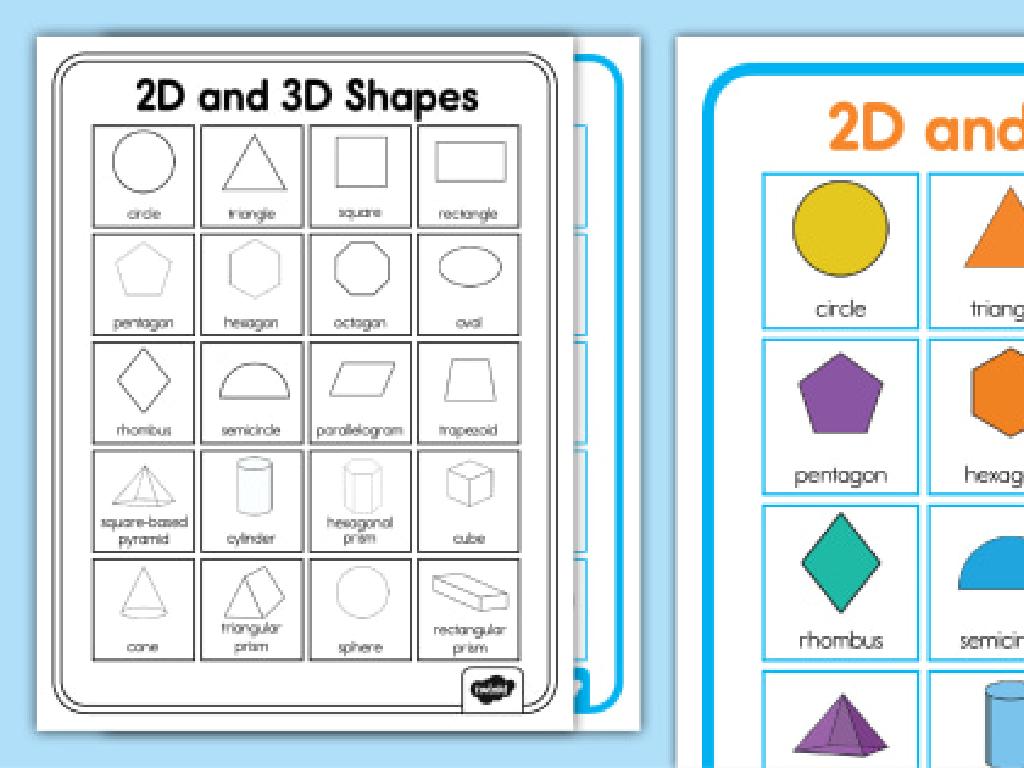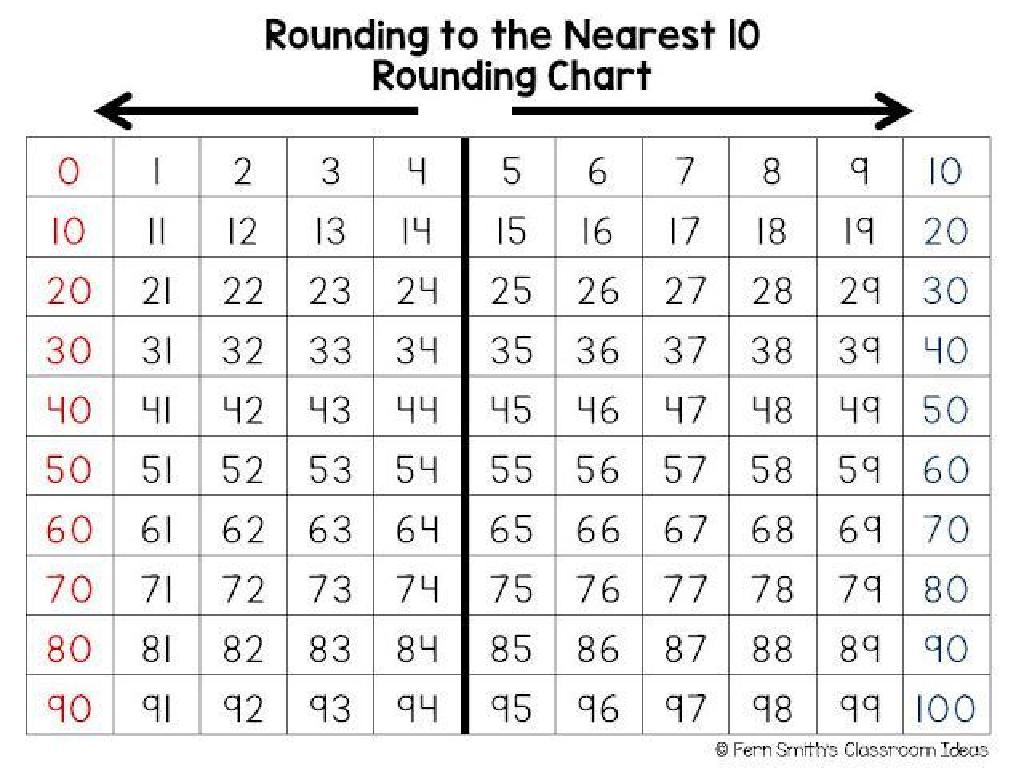Add And Subtract Positive And Negative Decimals
Subject: Math
Grade: Seventh grade
Topic: Operations With Rational Numbers
Please LOG IN to download the presentation. Access is available to registered users only.
View More Content
Understanding Positive & Negative Decimals
– Grasp positive & negative decimals
– Decimals represent parts of a whole, like $2.50 or -4.75
– Daily use of decimal numbers
– Used in money, measurements, and statistics
– Adding & subtracting decimals
– Combining and comparing amounts, balancing budgets
– Overview of today’s lesson
|
This slide introduces the concept of positive and negative decimal numbers, setting the stage for understanding operations with rational numbers. Emphasize that decimals are everywhere in daily life, from handling money to measuring ingredients for a recipe. Explain that adding and subtracting decimals is similar to working with whole numbers, but requires careful alignment of the decimal point. Today’s lesson will cover the rules and methods for performing these operations, including dealing with positive and negative values. Encourage students to think of real-life scenarios where they use decimals, and prepare them for practical exercises to follow.
Understanding Rational Numbers
– Define rational numbers
– Numbers that can be expressed as a fraction a/b, where a and b are integers and b is not zero.
– Examples: Positive & negative decimals
– Positive example: 3.5, Negative example: -2.75
– Review decimal place values
– Importance of tenths, hundredths, thousandths places in decimals.
– Adding & subtracting decimals
|
This slide introduces the concept of rational numbers, which are any numbers that can be expressed as a fraction of two integers, with a non-zero denominator. Provide examples of positive and negative decimals to illustrate rational numbers in a form familiar to students. Review place value to ensure students understand how to properly align decimals during addition and subtraction. Emphasize the role of place value in accurately adding and subtracting positive and negative decimals. This foundational knowledge is crucial for students to perform operations with rational numbers effectively.
Adding Positive Decimals
– Rules for adding decimals
– Always line up the decimal points and add like whole numbers.
– Align decimal points
– Ensures accurate addition, prevents mistakes.
– Example: 3.25 + 4.75
– Add 3.25 and 4.75: align decimals, sum is 8.00.
|
When teaching students to add positive decimals, start with the basic rules of decimal addition. Emphasize the importance of aligning the decimal points vertically before proceeding with the addition, as this is crucial for maintaining place value accuracy. Use clear examples, such as adding 3.25 and 4.75, to demonstrate the process. Show students how to carry over if necessary and how to fill in zeros to keep the columns straight. This slide will help students understand the concept of adding decimals and prepare them for more complex problems involving both positive and negative numbers.
Adding Negative Decimals
– Comprehend negative values
– Negative numbers are to the left of zero on the number line.
– Rules for adding negatives
– To add negative decimals, combine their absolute values and give the sum a negative sign.
– Example: -2.5 + (-3.5)
– Combining -2.5 and -3.5 gives us -6.0, as we add 2.5 and 3.5 to get 6.0, then apply the negative sign.
– Practice with similar problems
|
This slide introduces students to the concept of adding negative decimals, a key skill in understanding operations with rational numbers. Begin by explaining negative values and their representation on the number line. Emphasize that adding two negative numbers results in a negative sum. Use the example -2.5 + (-3.5) to show the process step by step: find the absolute value of each number, add them together, and apply the negative sign to the result. Encourage students to practice with additional problems to reinforce the concept.
Subtracting Positive and Negative Decimals
– Subtraction: Inverse of Addition
– Think of subtraction as adding the opposite number
– Rules for Subtracting Decimals
– Align decimal points, subtract like positive numbers
– Example: 6.2 – 3.1
– Subtracting a positive, result is less than 6.2
– Example: -4.5 – (-2.3)
– Subtracting a negative is like adding; -4.5 + 2.3
|
This slide introduces the concept of subtraction of decimals as the inverse operation of addition. Emphasize that subtraction can be thought of as adding the opposite. For example, subtracting a positive is the same as adding a negative. When subtracting decimals, it’s crucial to align the decimal points to ensure accurate calculation. Provide the examples 6.2 – 3.1 to illustrate straightforward subtraction, and -4.5 – (-2.3) to show how subtracting a negative number translates to addition. Encourage students to practice with additional examples and to check their understanding by considering the rules for adding and subtracting positive and negative numbers.
Mixed Operations with Decimals
– Combine addition and subtraction
– Follow the order of operations
– Remember PEMDAS: Parentheses, Exponents, Multiplication/Division, Addition/Subtraction
– Example: 7.6 + (-2.4) – 3.2
– 7.6 + (-2.4) = 5.2; 5.2 – 3.2 = 2.0
– Practice with mixed decimal problems
– Solve problems with both positive and negative decimals
|
This slide focuses on practicing mixed operations with decimals, emphasizing the importance of combining addition and subtraction correctly and following the order of operations. Start with a review of the order of operations (PEMDAS) and then apply it to an example with both positive and negative decimals. Encourage students to solve the example step by step, first combining the positive and negative numbers, and then proceeding with the subtraction. Provide additional practice problems with varying levels of complexity to ensure students are comfortable with the concept. Remind them to work carefully through each step and check their work.
Applying Decimal Operations in Everyday Life
– Understanding decimal operations
– Calculating change in real life
– If an item costs $7.25 and you pay $10, subtract to find change.
– Balancing a budget with decimals
– Keep track of expenses and income, ensuring the total makes sense.
– Interactive example: snack purchase
– You buy a snack for $4.50, pay with $10. How much is your change?
|
This slide aims to show students how decimal operations are used in everyday scenarios such as making purchases and managing money. Emphasize the importance of understanding how to add and subtract decimals to calculate the correct amount of change when shopping or to maintain a balanced budget. For the interactive example, guide the students through the process of subtracting $4.50 from $10.00, ensuring they line up the decimal points correctly. This will help them see the practical application of what they learn in class and understand the relevance of math in daily life. Encourage students to come up with similar examples and solve them.
Class Activity: Decimal Operations
– Pair up for problem-solving
– Solve real-world decimal problems
– E.g., Calculating money spent or distance traveled
– Discuss solutions with your partner
– Explain your thinking process
– Share methods with the class
|
This activity is designed to encourage collaborative learning and application of decimal operations in real-life scenarios. Students should be paired up to foster teamwork. Provide them with a worksheet containing various addition and subtraction problems that involve positive and negative decimals, ideally set in relatable contexts such as handling money or measuring distances. After solving the problems, students should discuss their solutions and methods with their partners to reinforce their understanding. Conclude the activity with a class discussion where pairs can share their methods and learn from each other. This will help students see different approaches to solving decimal problems and enhance their problem-solving skills.
Review and Reflect: Decimals
– Recap adding/subtracting decimals
– Review steps for decimal operations
– Discuss activity challenges
– Share difficulties and learn from them
– Engage in Q&A session
– Ask questions about today’s lesson
– Clarify any doubts
|
This slide aims to consolidate the students’ understanding of adding and subtracting positive and negative decimals. Begin with a brief recap of the methods used for decimal operations, ensuring to highlight the importance of aligning the decimal points and using zeros as placeholders. Open the floor for students to discuss any challenges they encountered during the class activity, fostering a collaborative environment where they can learn from each other’s experiences. Proceed to a Q&A session, encouraging students to ask questions to clear up any confusion. This is a crucial step to ensure that all students are on the same page before moving forward. The teacher should be prepared with additional examples to clarify concepts if needed and to reinforce learning through repetition and variation in problem types.
Homework: Decimals & Rational Numbers
– Practice adding/subtracting decimals
– Solve provided decimal problems
– Use the worksheet to practice with positive and negative decimals
– Review rational number operations
– Go over your notes on adding and subtracting rational numbers
– Get ready for a mini-quiz next class
– The quiz will cover all operations with rational numbers
|
This homework assignment is designed to reinforce students’ understanding of adding and subtracting positive and negative decimals. Provide a worksheet with a variety of problems that require students to apply their knowledge of decimal operations. Encourage them to review their class notes, especially the rules for combining positive and negative numbers. The mini-quiz in the next class will assess their grasp of rational number operations, so they should be prepared to solve problems involving addition, subtraction, multiplication, and division of rational numbers. Offer some example problems during class and remind students of the resources they can use, such as textbooks and online materials, to study.





